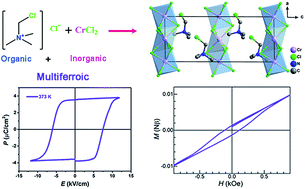Coexistence of magnetic and electric orderings in a divalent Cr2+-based multiaxial molecular ferroelectric†
Abstract
Multiferroic materials have attracted great interest because of their underlying new science and promising applications in data storage and mutual control devices. However, they are still very rare and highly imperative to be developed. Here, we report an organic–inorganic hybrid perovskite trimethylchloromethylammonium chromium chloride (TMCM–CrCl3), showing the coexistence of magnetic and electric orderings. It displays a paraelectric–ferroelectric phase transition at 397 K with an Aizu notation of 6/mFm, and spin-canted antiferromagnetic ordering with a Néel temperature of 4.8 K. The ferroelectricity originates from the orientational ordering of TMCM cations, and the magnetism is from the [CrCl3]− framework. Remarkably, TMCM–CrCl3 is the first experimentally confirmed divalent Cr2+-based multiferroic material as far as we know. A new category of hybrid multiferroic materials is pointed out in this work, and more Cr2+-based multiferroic materials will be expectedly developed in the future.

- This article is part of the themed collections: Most popular 2021 main group, inorganic and organometallic chemistry articles, 2021 and In celebration of Chinese New Year, 2022


 Please wait while we load your content...
Please wait while we load your content...